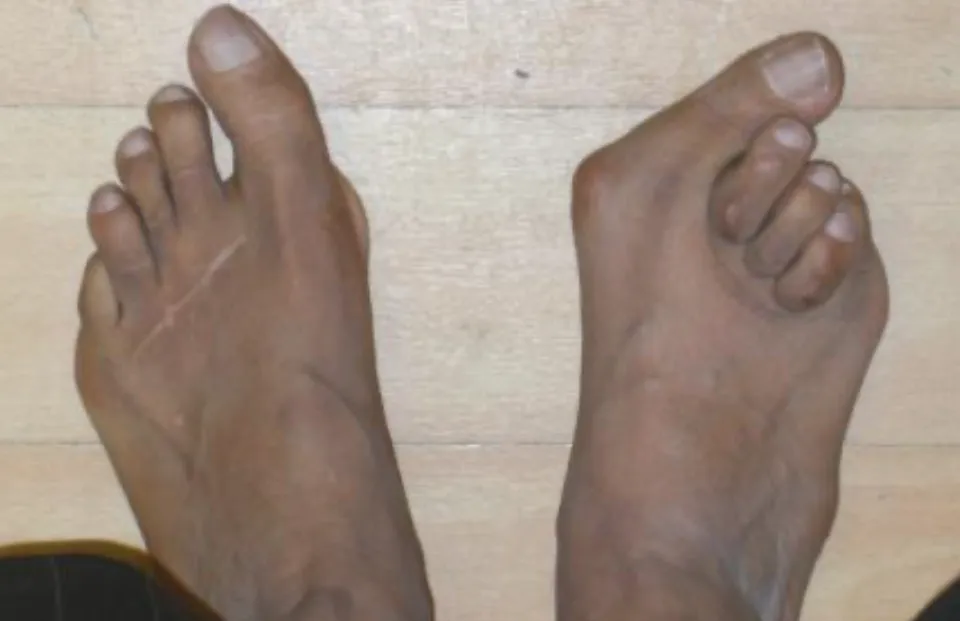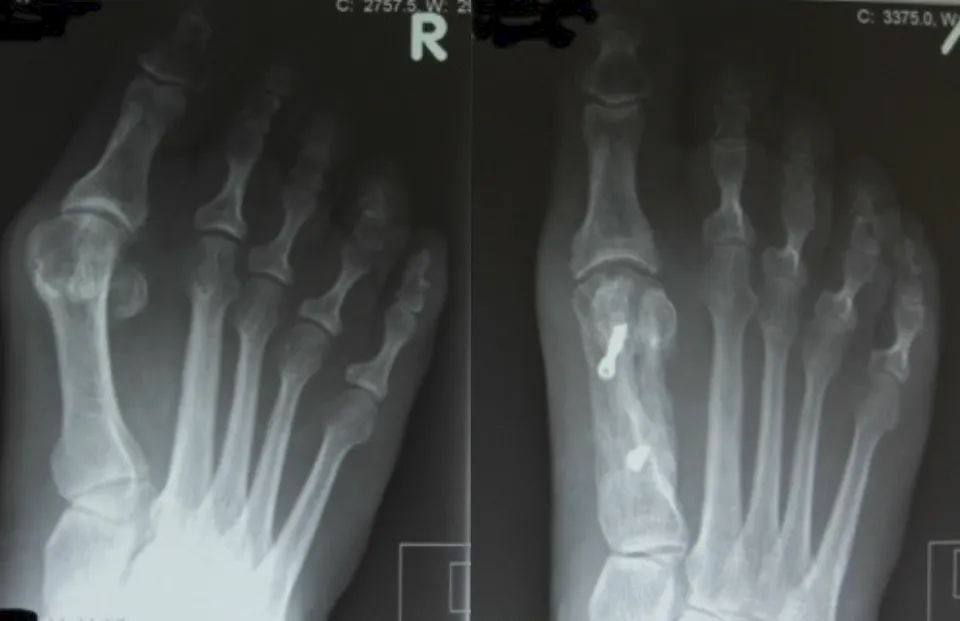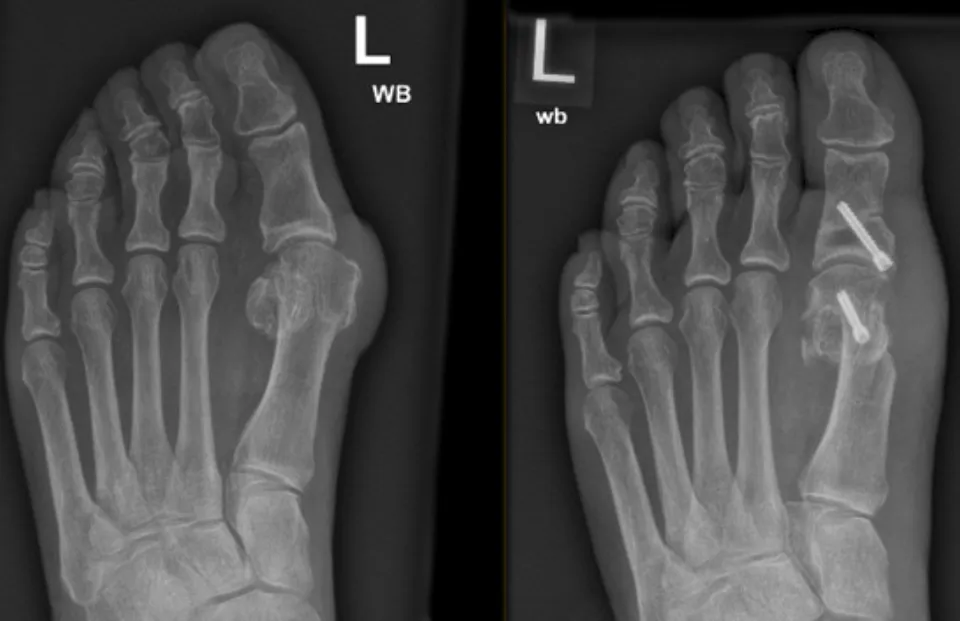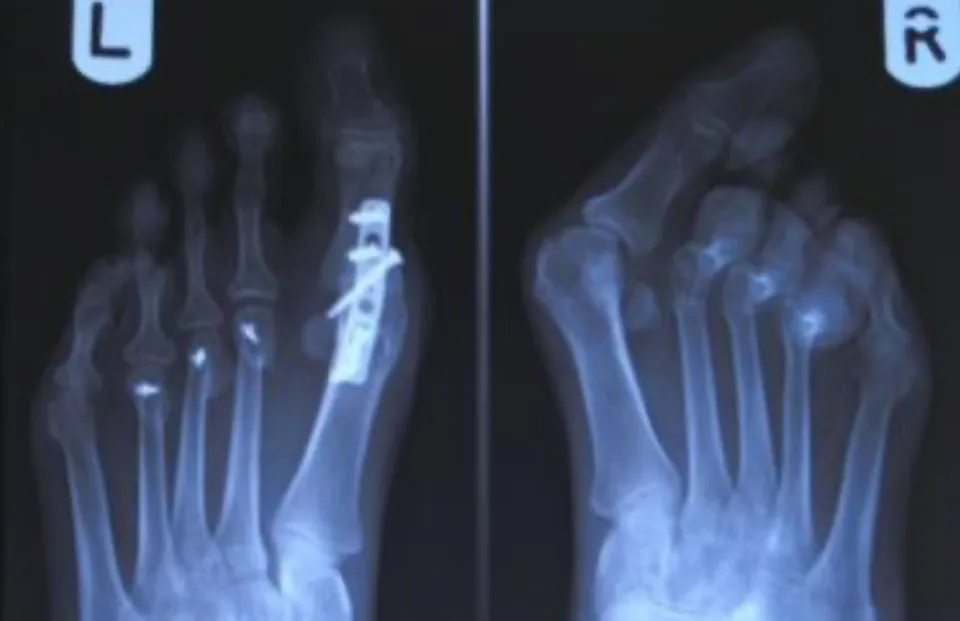Bunion - Open Surgery Chevron / Scarf Osteotomy
A “Bunion” is an enlarged bump or prominence at the side of the Big toe. Its due to the Big toe or Hallux being pulled over to the side, making the metatarsal head very prominent. This bunion prominence becomes painful and swollen, eventually requiring treatment. Sadly, there are no braces or splints that can prevent it getting worse. Wider fitting shoes can certainly help, but there is only so much that can done with shoeware. Once the pain gets bad enough, this requires surgery - to remove the boney prominence and realign the hallux with "metatarsal osteotomies” to cut and reposition the bones.
The bunion often affects the lesser toes too, causing problems with Claw toes, Hammer Toes and Metatarsalgia (pain under the ball of the foot). This will need addressing at the same time as the bunion surgery.

Left side (was the worst) 1 yr after surgery and Right side prior to surgery
Surgery
The goal of the surgery is to remove the bunion prominence and realign the toe so that it stays straight for ever. The most common type of surgery is cut and realign the metatarsal (commonly using a Scarf or Chevron osteotomy) and to cut and realign the toe (an akin osteotomy). See video below. This can be done using key hole or open techniques.
I use both techniques, choosing which one I think will address the problem best, depending on the severity of the hallux valgus and the degree of realignment required.
Open Surgery
Metatarsal Osteotomies (Chevron or Scarf Osteotomy)
This is performed using open techniques with an incision along the metatarsal of 4-5cm. The stretched capsule and ligaments are lifted off and the bunion prominence is removed with a saw. The metatarsal is then divided using specially orientated cuts, realigned and fixed in place with 1 or 2 screws. The stretched capsule and ligaments are then tightened to reconstruct them, with strong sutures.

Mixed MI & Open surgery
Having performed thousands of bunion surgeries, this is the technique I use for the majority of corrections. The surgery is performed using intra-operative Xray guidance for precision.
A small incision is made over the bunion of 3-4cm and the capsule lifted off. The bunion prominence is removed and a modified chevron osteotomy used for the metatarsal realignment. This is securely fixed with one screw and the capsule and ligaments reconstructed and tightened. A Minimally Invasive Akin osteotomy is then performed, using the 2mm burr passed percutaneously at the proximal phalance of the hallux. This is fixed with one screw, passed percutaneously. I find this combination of surgery techniques provides the optimum in minimising the soft tissue trauma and in maximising accurate surgical correction.

MTP Fusion Hallux valgus with arthritis or Extreme Hallux Valgus
In the most severe cases its often necessary to fuse the big toe straight “MTP fusion” or “MTP arthrodesis”. This procedure removes the bad joint surfaces and then fuses the joint straight forever. (For further information see Hallux MTP fusion)
In more severe hallux valgus, there are often deformities in the lesser toes, with claw toes deformity or pain underneath the foot “metatarsalgia”. Both are due to the longstanding dysfunction of the big toe causing overload of the lesser toes. These deformities will need addressing at the same time and surgery can be complex, with multiple operations taking 1-2 hours.


Post op Left side & Pre Op Right side

In all these surgeries, the capsule repair must be protected with the specialised dressing for 2 weeks and the osteotomy requires protection in the post operative shoe for 6 weeks.
Elevation of the foot above the pelvis (45 mins / hour) for the first 10 days is vitally important to prevent infection. Naturally, small periods of walking and standing are necessary.
This type of operation and the post operative shoe allow weight bearing (walking) immediately. Often this may be too uncomfortable for the first week. Crutches are usually necessary for the first for 4-6 weeks.
Risks of surgery
Stiffness & swelling
Initially the foot will be swollen and needs elevating. The swelling will disperse over the following weeks & months but will still be apparent at 6-9 months. The toe will be stiff but will normally regain its original movement.
Infection
There is always a risk of infection with surgery. You will be given 1 dose of intravenous antibiotics during surgery. The best way to reduce your chances of acquiring an infection is to keep the foot elevated for 7 days. If there is an infection, it normally resolves with a course of oral antibiotics.
Nerve damage
A nerve supplying the skin on the side of the toe is at risk of damage. Usually it is just bruised and will recover. If the damage is permanent, it will leave a small patch of numbness. This does not normally cause any disability.
Undercorrection
Occasionally, the deformity of the toe is not wholly corrected. This is more common in severe cases. Rarely, this is problematic and requires further surgery.
Overcorrection
Very rarely, the toe can be over-straightened so that it angles away from the foot (hallux varus). This is a rare complication and usually requires further surgery.
Correction of Deformity
Excellent long lasting corrections are achieved. Naturally in the more severe cases, some recurrence can occur but usually with no or few symptoms. It is very rare to need revision surgery.
Blood Clots “DVT"
Because you will be walking on it immediately there is no need for any anticoagulation unless you are “high risk” with a previous history or family history of blood clots. The oral contraceptive pill will need to be stopped several weeks prior to surgery - please check this.
Preparation for Surgery
You should have received a letter detailing the codes and costs for the surgery and giving instructions on where to go and at what time. Please check these details carefully as you will be liable for any costs not covered by your insurers.
You will need to be nil-by-mouth – No food for 6 hours before surgery. Clear fluids can be taken for up to 2 hours before the operation.
MRSA status
Before or on admission to hospital a nasal swab will be taken to screen for MRSA. There is a small chance this is positive. If so your operation will be moved to the end of the list or rarely to another day to prevent cross infection.
Anaesthetic
The surgery is normally a daycase procedure, performed under a general anaesthetic with a local anaesthetic “Ankle Block" for additional pain relief. With modern anaesthetic techniques, It is no longer a very painful operation and most patients report discomfort afterwards.
Immediately after surgery
Following surgery, the toe is protected in a specialised dressing and postoperative shoe.
You will be seen by a physiotherapist on the ward, who will advise on walking and early rehabilitation. You will be allowed home only when you are comfortable and capable.
Recovery from surgery
The capsule repair must be protected with the specialised dressing for 2 weeks and the osteotomy requires protection in the post operative shoe for 6 weeks.
Elevation of the foot above the pelvis (45 mins per hour) is is vitally important to prevent infection. Naturally, small periods of walking and standing are necessary.
This type of operation and the post operative shoe allow weight bearing (walking) immediately. Often this may be too uncomfortable for the first week and crutches are usually necessary for the first for 1-2 weeks.
Swelling
Many patients worry about the swelling. It is a natural response to the surgery and is slow to settle in this type of surgery - it takes 3 months to fit into all types of shoeware and 6-9 months to go.
Walking & Exercise
You can walk on the foot immediately, in the protective shoe. For the first 1-2 weeks you will be “housebound” looking after and elevating the foot. Each week the foot will be able to do more.
At 3-4 weeks light exercise can be done on the cross trainer or static bicycle.
In general it takes 3 months to walk a mile and 6 months to run a mile (usually it is a bit quicker than this!)
Physiotherapy
This can be started after 2 weeks.
Pain relief and take home medications
You will be given high doses of prescription painkillers to take home. Use these for the first 5-7 days and reassess.
Washing and Bathing
It’s important to keep the dressing completely dry – the nurses will show you how to do this with a waterproof cover.
Activity and time off work
In general, up to 4 weeks off work is required for sedentary posts such as office work, 6 weeks for standing or walking posts, 8 weeks for manual / labour posts.
When can I start to drive again?
The DVLA states that it’s the responsibility of the driver to ensure they are always in control of the vehicle. For the Left Foot, driving should be possible after a few days in an automatic car. Otherwise it is a minimum of 4 weeks to drive.
It remains your responsibility to drive safely and you should also check with your vehicle insurer to confirm you are covered.
Results of surgery
This type of surgery is very reliable and durable and works indefinitely for the majority. However the foot is a very complex area and although rare, recurrences do happen - understandably these are more common in the severe cases.